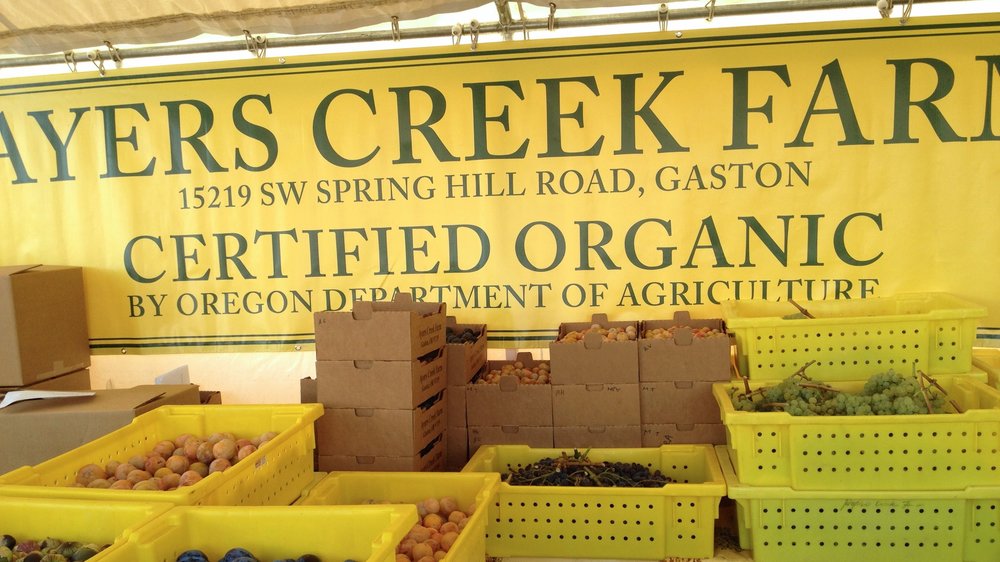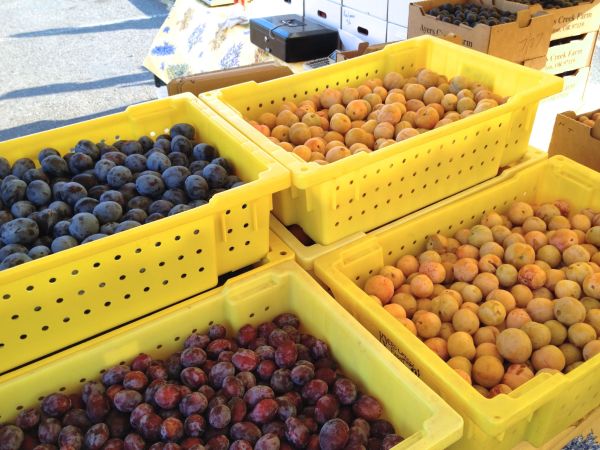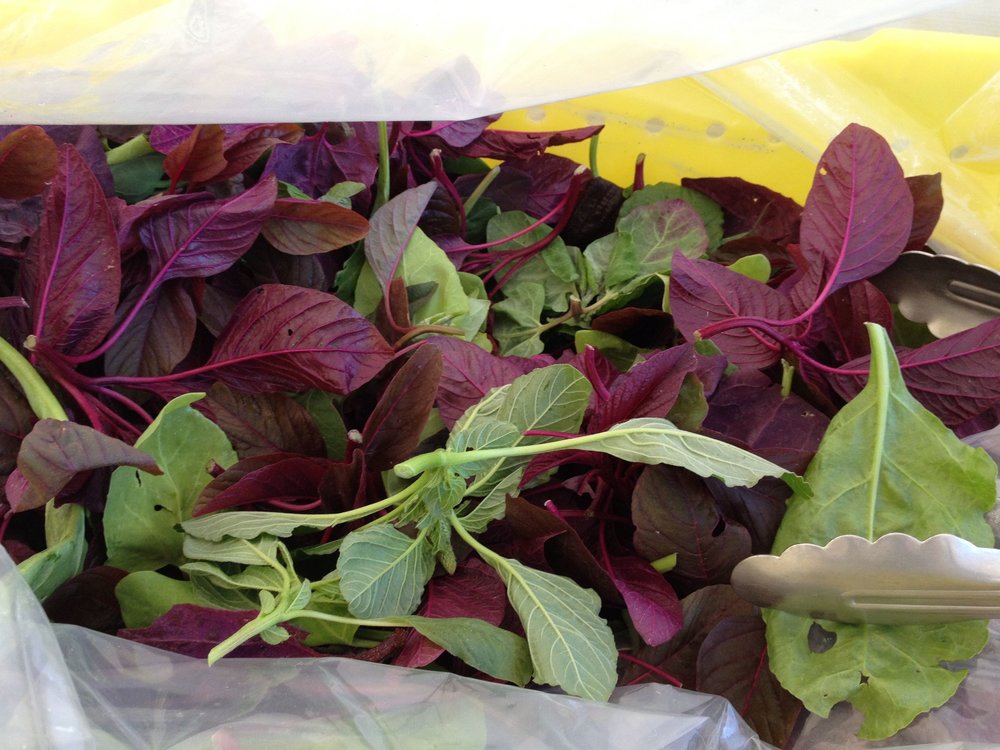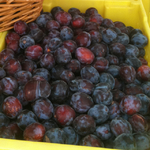Another week, another market, again starting at 10:00 AM, Hillsdale time, and the costermongers of Gaston will be there.
Our stall should have the following fruits and vegetables:
Berries: We are in the trough between the early season berries and the Chesters. So it is maybe this, maybe that, but not too much of any particular berry.
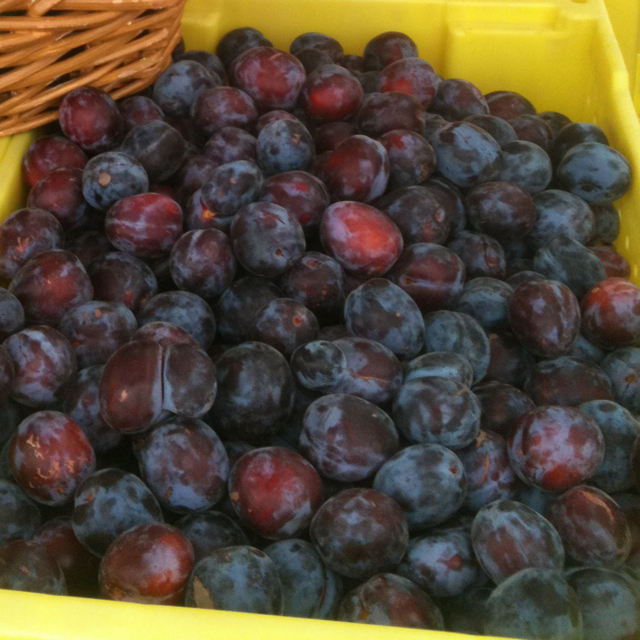 Imperial EpineusePrunes: Imperial Epineuse is a table prune. It was introduced to Oregon around 1900 but never found much favor among the state's prune growers. A pity, because it is early and a very flavorful plum. It is thought to have a touch of damson in its lineage, which accounts for its very fine texture relative to other prunes.
Imperial EpineusePrunes: Imperial Epineuse is a table prune. It was introduced to Oregon around 1900 but never found much favor among the state's prune growers. A pity, because it is early and a very flavorful plum. It is thought to have a touch of damson in its lineage, which accounts for its very fine texture relative to other prunes.
Frikeh & Preserves
Mixed greens: Both salad and cooking greens as in earlier weeks.
Garlics & Shallots: The ugly shallot is the French Grey, the True Shallot. They never send up a flower stalk and have better flavor than the onion-like False or Jersey Shallot that is most commonly encountered in the stores and markets. They are ugly so they sell poorly, a pity.
Summer Squash: Costata Romanesco
As summer progresses, the matter of zucchini's fecundity comes to the fore. Newspapers and magazines regale us with the travails of home gardeners who try to foist the excess on neighbors and friends. All manner of recipes are proposed to deal with the burden. So why are people who don't garden, and should be grateful for the generosity of the plant and its owner, so resistant to the gift?
Although it is found in the vegetable section of the grocery store, and is treated as a vegetable in the kitchen, the zucchini is, in fact, a fruit. As we have noted many times, the first harvest of berries are the densest and highest quality. As the season progresses, the concentration of pectins and acids drop and the fruit has a thinner skin, all contributing to a change in flavor. On the blackberries, for example, we make six rotations through the field, harvesting roughly 60% of the field's production. The remaining fruit is just not worth harvesting, the berries have lost their bright quality, have a bitter edge and the fragrance is suddenly unappealing. Without fail, on the seventh rotation the field rests. In grapes, we thin approximately 40% of the clusters in advance, once again producing a lower yield than the vine would produce without our interference, otherwise the flavor of the harvested grapes would be compromised. In melons, only the first two fruits on the plant are worth eating even though the plant produces several more. A similar pattern develops in the snap beans, tough skin and a lack of flavor push us to abandon the vines long before they finish producing beans.
With the zucchini and other summer squash, the same reduction in fruit quality happens as the plant ages. The first four to six fruits are dense and sublime in every respect. By the time you get to the eighth fruit or so on the plant, they are not worth a tinker's dam. No longer do you want to simply sauté them in a bit of olive oil and savor their flavor. They don't have any, at least as a positive attribute, and so a battalion of seasonings is mustered in order to make the fruit palatable. It is not because we are bored with the fruit, as some food writers assert. The plant has spent its energy producing the early fruit and it is time for the gardener to move on to another food. Left on its own, a zucchini plant carries just one or two fruits to maturity, by removing the immature fruits we push it to produce more but the plant has limits. Foisting the unwanted fruit of a spent plant on your friends and neighbors is a cruel mockery. When we were growing melons, the first few ripe fruit went to the staff who helped plant them as a gesture of thanks. A real gift to the neighbors would be the first and most delicious zucchini of the season, instead of the debased surfeit. When you stand staring at the spice cabinet trying to decide what flavor is best with squash, it is time to walk away from the fruit, not next door with it.
"Shame on the wastrel," the human chorus cries, "wasting food is a sin against nature! The cultivator has brought this food forth from the earth, and you counsel denying others the pleasure of eating it!" "Hush," the farmer responds, "we are not alone here. We tend and harvest crops in joint effort with other creatures upon this earth, and it is they who have toiled and earned the surfeit." The chorus of the field flora and fauna reply, "Yes gentle farmer, leave us the latter day squash. Let them ripen in the field and we will build a great and tilth-full soil. It is merely a silly, self-centered conceit that if humans do not use it, there is waste." As this exchange from Ayersini's translation of Carolystra and Antonocoles (the respected Gastonian Folio) stresses, we farm in consort with billions of other organisms, nothing goes to waste when left in the field.
Once the harvest has ceased, zucchini plants continue to grow, the fruits ripen and set seed. The mature fruits are between two and three feet long, and their ribs turn a deep golden-orange. During this time, they also produce substantial amounts of fibrous woody stem that will contribute organic matter to the soil. All winter long, the tops provide a shelter for a range of insects, spiders and small mammals, a village of life. Birds forage among the decaying remains. Beneath the ground, there is a deep tap root and and a more extensive fibrous root system that maintain the tilth of the soil through the winter idyl, and providing food for the creatures that live there. To every extent possible, we leave our cornstalks, tomato plants, squash and bean vines and other crops standing in the field through the winter. In our experience, the instinct to cleanup does more harm than good. No better job for a spent plant than to leave it in place to protect and improve the fertility of the garden. Think of it as a deferred meal. The unkempt garden will serve you well.
See you all Sunday,
Carol & Anthony Boutard Ayers Creek Farm
